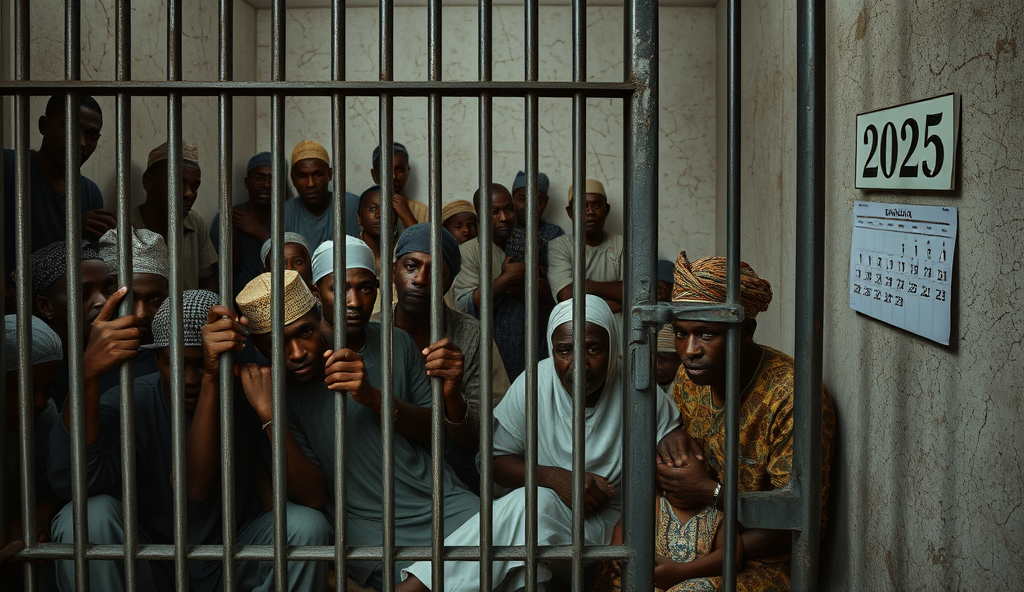Introduction to Prison Congestion in Nigeria
Nigeria’s correctional facilities face severe overcrowding, with inmate populations exceeding 150% capacity in many states, according to 2023 data from the Nigerian Correctional Service. This crisis stems from systemic issues like delayed trials, with over 70% of detainees awaiting trial, exacerbating the strain on already limited prison infrastructure.
The human cost of overcrowded prisons in Nigeria includes heightened health risks, security challenges, and violations of inmates’ basic rights. For instance, Lagos’ Kirikiri Medium Security Prison, designed for 1,700 inmates, currently houses over 3,000, reflecting a nationwide pattern of infrastructure deficits.
As we examine this pressing issue, understanding the structure of Nigeria’s prison system becomes crucial to identifying sustainable solutions. The next section will explore the historical and operational framework of these facilities, providing context for current reform efforts.
Key Statistics

Overview of the Nigerian Prison System
Nigeria’s correctional facilities face severe overcrowding with inmate populations exceeding 150% capacity in many states according to 2023 data from the Nigerian Correctional Service.
The Nigerian prison system operates under the Nigerian Correctional Service Act 2019, which rebranded prisons as correctional facilities to emphasize rehabilitation over punishment. With 244 facilities nationwide, the system manages both convicted inmates and awaiting-trial detainees, who constitute 72% of the 76,000 total inmate population as of 2023 NCoS reports.
These correctional centers are categorized into maximum, medium, and minimum security facilities, though most struggle with outdated infrastructure from colonial-era designs. For example, Enugu Prison built in 1915 still operates at 180% capacity despite multiple renovation attempts, mirroring systemic challenges across states.
This structural foundation helps explain why prison congestion persists despite policy changes, setting the stage for examining root causes in the next section. The disconnect between legislative intent and operational realities remains a critical barrier to meaningful reform.
Causes of Prison Congestion in Nigeria
The Nigerian prison system operates under the Nigerian Correctional Service Act 2019 which rebranded prisons as correctional facilities to emphasize rehabilitation over punishment.
The overwhelming 72% awaiting-trial population, highlighted in NCoS 2023 data, stems from systemic delays in Nigeria’s justice system, where cases average 5-10 years due to understaffed courts and logistical bottlenecks. Colonial-era infrastructure like Enugu Prison exacerbates overcrowding, as modern inmate populations triple original design capacities without proportional facility upgrades.
Over-reliance on incarceration for minor offenses persists despite the Correctional Service Act 2019’s emphasis on alternatives, with 43% of detainees held for non-violent crimes according to CLEEN Foundation reports. Poor inter-agency coordination between police, courts, and correctional services creates administrative logjams, leaving thousands in prolonged detention without trial.
Underfunding remains critical, with only 15% of allocated budgets reaching facilities, perpetuating capacity deficits that hinder rehabilitation programs. These operational gaps between policy frameworks like the Act and ground realities set the stage for examining how congestion distorts judicial processes, as explored next.
Impact of Prison Congestion on the Justice System
The overwhelming 72% awaiting-trial population stems from systemic delays in Nigeria’s justice system where cases average 5-10 years due to understaffed courts and logistical bottlenecks.
Prison congestion directly undermines judicial efficiency, with Lagos courts reporting 40% case adjournments due to inmate transportation failures caused by overcrowded correctional facilities. This systemic bottleneck perpetuates the cycle of delayed trials, further swelling the 72% awaiting-trial population highlighted in NCoS 2023 data.
Overcrowded prisons in Nigeria compromise detainees’ rights, as evidenced by 2022 NHRC reports showing 68% of inmates lack access to legal representation, violating constitutional provisions for fair hearing. Such conditions erode public trust in the justice system while increasing recidivism rates among minor offenders held alongside hardened criminals.
The strain on Nigeria’s correctional facilities has birthed parallel judicial crises, including witness intimidation risks and evidence tampering in congested holding cells. These operational failures necessitate urgent policy interventions, which will be examined in the subsequent analysis of current government measures.
Current Policies to Address Prison Congestion in Nigeria
Prison congestion directly undermines judicial efficiency with Lagos courts reporting 40% case adjournments due to inmate transportation failures caused by overcrowded correctional facilities.
The Nigerian government has implemented the Administration of Criminal Justice Act (ACJA) 2015 to expedite trials, mandating monthly case reviews for awaiting-trial inmates, though enforcement remains inconsistent across states. Additionally, the Correctional Service Act 2019 introduced non-custodial measures like community service for minor offenses, potentially reducing the 72% awaiting-trial population highlighted in NCoS data.
Recent infrastructure projects include constructing six new 3,000-capacity custodial centers, aiming to alleviate the 150% overcapacity in facilities like Ikoyi Prison. However, these efforts face funding delays, with only two facilities reaching 40% completion as of Q1 2024, per Budget Office reports.
Judicial reforms include special courts for speedy trials of minor offenses and virtual court proceedings piloted in Lagos, addressing the 40% adjournment rate caused by transportation challenges. These measures lay groundwork for more comprehensive initiatives, which we’ll examine next regarding government-led overcrowding reduction programs.
Initiatives by the Nigerian Government to Reduce Prison Overcrowding
The Nigerian government has implemented the Administration of Criminal Justice Act (ACJA) 2015 to expedite trials mandating monthly case reviews for awaiting-trial inmates though enforcement remains inconsistent across states.
Building on earlier judicial and infrastructural reforms, the federal government launched the Nigerian Correctional Service Decongestion Program in 2022, which has facilitated the release of 4,800 inmates through accelerated case reviews and payment of fines for minor offenders. The program targets 15 overcrowded facilities, including Kirikiri and Port Harcourt prisons, where inmate populations exceed 200% capacity.
Complementing these efforts, the Ministry of Justice introduced plea bargaining guidelines in 2023, resulting in 1,200 resolved cases within six months, primarily for non-violent offenses like petty theft and traffic violations. This aligns with the Correctional Service Act’s emphasis on alternatives to incarceration, though implementation gaps persist in rural states.
These government-led measures create a framework for collaboration with civil society groups, whose complementary interventions we’ll explore next regarding NGO roles in alleviating prison congestion. The partnership approach addresses systemic bottlenecks while leveraging existing legal reforms like ACJA 2015.
Role of Non-Governmental Organizations in Alleviating Prison Congestion
Civil society groups like the Prisoners’ Rehabilitation and Welfare Action (PRAWA) have partnered with the government to expand legal aid services, assisting 3,200 inmates with case reviews since 2022 under the ACJA framework. These NGOs bridge implementation gaps in rural areas by deploying paralegals to 14 states, including Benue and Kogi, where plea bargaining adoption remains low.
Organizations such as the Legal Defence and Assistance Project (LEDAP) have facilitated bail for 1,700 pretrial detainees through court monitoring and mediation programs, complementing the Correctional Service Decongestion Program’s focus on minor offenses. Their interventions align with human rights concerns in Nigerian prisons by targeting vulnerable groups like women and juveniles held for petty crimes.
While these efforts demonstrate progress, persistent justice system bottlenecks require deeper structural reforms, setting the stage for examining challenges facing prison decongestion policies. NGO initiatives highlight the need for sustained collaboration between state and non-state actors to address overcrowded prisons in Nigeria comprehensively.
Challenges Facing the Implementation of Prison Decongestion Policies
Despite NGO interventions like PRAWA’s case reviews and LEDAP’s bail facilitation, systemic hurdles persist, including underfunded courts and inadequate legal representation, which delay trials for 70% of Nigeria’s 76,000 inmates. Poor coordination between justice agencies exacerbates overcrowded prisons in Nigeria, with only 34% of correctional facilities meeting capacity standards as of 2023.
Geographical disparities further complicate decongestion efforts, as rural states like Benue lack sufficient magistrates to process plea bargains, leaving minor offenders detained for years. Infrastructure deficits, such as dilapidated courtrooms and limited digital case management systems, slow down the Correctional Service Decongestion Program’s rollout in 12 states.
These structural gaps underscore the need for holistic reforms beyond NGO partnerships, setting the stage for examining localized success stories in the next section. Addressing justice system bottlenecks requires synchronized policy adjustments and sustained investment in Nigeria’s penal infrastructure.
Case Studies of Successful Prison Decongestion Efforts in Nigeria
Lagos State’s fast-track courts reduced pretrial detention by 40% in 2022 through weekend arraignments and virtual hearings, demonstrating how infrastructure upgrades and procedural reforms can alleviate overcrowded prisons in Nigeria. Similarly, Kano’s Justice Sector Reform Team freed 387 inmates in six months by resolving minor cases through mediation, proving that localized interventions can bypass systemic bottlenecks in Nigeria’s correctional facilities crisis.
In Edo State, collaboration between the Ministry of Justice and the Nigerian Correctional Service saw 512 inmates released via plea bargains in 2023, cutting detention costs by ₦127 million annually while addressing delayed trials contributing to jail congestion. These models highlight scalable solutions despite persistent challenges like underfunding, setting the stage for broader policy recommendations.
Recommendations for Sustainable Solutions to Prison Congestion
Building on the success of Lagos’ fast-track courts and Edo’s plea bargain system, Nigeria should institutionalize these reforms by allocating 15% of state justice budgets to alternative dispute resolution and virtual court infrastructure. The federal government could replicate Kano’s mediation model nationwide by training 500 community mediators annually to decongest prisons of minor offenders, potentially freeing 10,000 inmates yearly based on current case backlogs.
To address systemic delays, the Nigerian Correctional Service should implement a centralized digital case management system, integrating with courts and police to reduce the 72% of inmates awaiting trial—a measure that saved Ghana 30% in detention costs within two years. States like Rivers and Kaduna could pilot this with technical support from the Justice Reform Project, using lessons from Edo’s ₦127 million cost-saving initiative.
Finally, the National Assembly should amend the Administration of Criminal Justice Act to mandate monthly jail delivery sessions in all 36 states, backed by special courts for speedy trials—a strategy that reduced Kenya’s pretrial population by 22% in 2021. These policy shifts, combined with sustained funding for infrastructure upgrades, would create lasting solutions to Nigeria’s correctional facilities crisis while upholding human rights standards.
Conclusion on Addressing Prison Congestion in Nigeria
Nigeria’s prison congestion crisis demands urgent, multi-sectoral reforms, as highlighted by the 76,000 inmates crammed into facilities built for 50,000. While initiatives like the Administration of Criminal Justice Act (2015) and non-custodial measures show promise, systemic bottlenecks in justice delivery and infrastructure deficits persist.
The Nigerian Correctional Service’s partnership with states to decongest prisons through accelerated case hearings has freed over 5,000 inmates since 2020, yet delayed trials remain a key driver of overcrowding. Sustainable solutions must prioritize alternatives to incarceration, such as community service and parole, while expanding rehabilitation programs.
Looking ahead, aligning prison reforms with broader justice sector overhauls will be critical to reducing Nigeria’s inmate population surge. Without addressing root causes like prolonged pretrial detention and inadequate funding, temporary measures risk yielding only marginal relief.
The path forward requires sustained political will and inter-agency collaboration to transform correctional facilities into centers of true reformation.
Frequently Asked Questions
What immediate steps can the Nigerian government take to reduce prison congestion given budget constraints?
Prioritize fast-track courts for minor offenses and leverage plea bargaining, as done in Edo State, which saved ₦127 million annually while freeing 512 inmates.
How can Nigeria improve coordination between police, courts, and correctional services to address delayed trials?
Implement a centralized digital case management system like Ghana's model, which reduced detention costs by 30% by streamlining inter-agency data sharing.
What role can state governments play in replicating Lagos' success with fast-track courts?
Allocate 15% of justice budgets to virtual court infrastructure and weekend arraignments, which cut Lagos' pretrial detention by 40% in 2022.
How can Nigeria sustainably fund prison infrastructure upgrades amid competing priorities?
Partner with private sector through PPP models and earmark a percentage of recovered assets for facility renovations, as proposed in the 2024 Justice Sector Reform Plan.
What policy adjustments are needed to ensure the Correctional Service Act 2019's non-custodial measures are fully implemented?
Amend the ACJA to mandate monthly jail delivery sessions nationwide and train 500 community mediators annually to handle minor offenses outside prisons.


